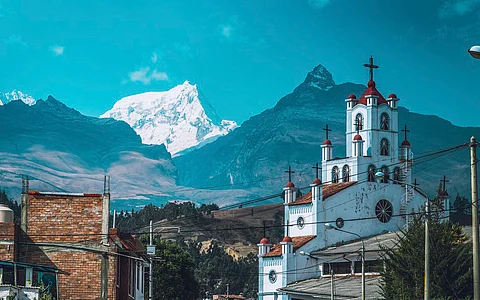

Peruvian farmer and mountain guide Saúl Luciano Lliuya reached the Higher Regional Court in Hamm, North Rhine-Westphalia (Germany) for his climate lawsuit hearing against energy company RWE on March 17, 2025. The lawsuit is supported by Germanwatch and Stiftung Zukunftsfähigkeit.
The lawsuit against RWE argues that the company’s historical greenhouse gas emissions have fueled global warming, accelerating glacial melt above his hometown of Huaraz.
For years, glacial melting due to climate change has caused the water level of lake Palcacocha to rise. The lake is located in the mountain range of Cordillera Blanca in Peru. Climate change is increasing the risk of large ice blocks breaking off the glaciers (of the Palcaraju and Pucaranra summits) and falling into the lake.
Below the lake lies the city of Huaraz. In the event of an avalanche, the meltwater of the lake could flood and destroy large parts of the city.
Lliuya began legal action against the German energy company in November 24, 2015. He said that RWE, as one of Europe’s largest CO2 emitters, shares responsibility for climate change and the threat of the lake’s flooding that would affect up to 50,000 people.
In 2022, a nine-member delegation of German judges and experts arrived at the Palcacocha glacier to assess the risk for the 120,000 people living below it in the city of Huaraz.
The inspection was ordered by the Higher Regional Court in Hamm, where Lliuya submitted his claim against RWE after the case in Essen was dismissed.
The claim at the centre of the lawsuit states the company, which does not operate in Peru, has contributed about 0.47 per cent of the emissions causing global climate change and that it should therefore be responsible for 0.47 per cent of the cost spent by Lliuya and/or third parties on implementing safety measures to protect his house and property.
This 0.47 per cent figure is based on a scientific attribution report published in 2014 by Richard Heede of Climate Accountability Institute, which stated that just 90 companies are responsible for two-thirds of all greenhouse gases (GHGs) emitted between 1854 and 2010.
Roda Verheyen, lawyer for the plaintiff, said the court would have to decide whether there is a sufficient legal risk for Lliuya to hold RWE proportionally liable for the flood risk under German civil law.
RWE said it has complied with German government greenhouse gas emissions guidelines and has a target of being carbon-neutral by 2040.
The case has already set a precedent. Regardless of the result, the use of courts and legal mechanisms to demand compensation for climate impacts will grow as emissions and the frequency and intensity of extreme weather events continue to rise.